Color and Attractant Preferences of the Black Fig Fly, Silba adipata: Implications for Monitoring and Mass Trapping of This Invasive Pest
Simple Summary
Abstract
1. Introduction
2. Materials and Methods
2.1. Insects, Attractants, and Fig Orchards
2.2. Visual Attraction to Different Colors: Laboratory Experiment
2.3. Visual Attraction to Different Colors in Fig Orchards
2.4. Attraction to Odors Under Laboratory Conditions
2.4.1. Comparison of Types of Attractants
2.4.2. Comparison of Ammonium Salts
2.5. Efficacy of Attractants in Fig Orchards
2.6. Attraction to Ammonium Sulfate and Fig Latex in Fig Orchards
2.7. Release of Ammonia from Traps
2.8. Statistical Analysis
3. Results
3.1. Visual Attraction to Different Colors: Laboratory Experiment
3.2. Visual Attraction to Different Colors in Fig Orchards
3.3. Attraction to Odors Under Laboratory Conditions
3.3.1. Comparison of Types of Attractants
3.3.2. Comparison of Ammonium Salts
3.4. Efficacy of Attractants in Fig Orchards
3.4.1. Silba adipata
3.4.2. Neosilba spp. and Lonchaea spp.
3.5. Attraction to Ammonium Sulfate and Fig Latex in Fig Orchards
4. Discussion
5. Conclusions
Supplementary Materials
Author Contributions
Funding
Data Availability Statement
Acknowledgments
Conflicts of Interest
References
- Giliomee, J.H.; Venter, E.; Wohlfarter, M. Mediterranean black fig fly, Silba adipata McAlpine (Diptera: Lonchaeidae), recorded from South Africa. Afr. Entomol. 2007, 15, 383–384. [Google Scholar] [CrossRef]
- NAPPO, North American Plant Protection Organization. Detection of Black Fig Fly (Silba adipata McAlpine) in the Municipality of Ayala, State of Morelos, 17 March 2020. Available online: https://www.pestalerts.org/nappo/official-pest-reports/926/ (accessed on 24 June 2025).
- Britt, K.E.; Gordon, P.E.; Faber, B.A.; Rios, S.I.; Wilson, H. First report of black fig fly, Silba adipata (Diptera: Lonchaeidae), in the United States. J. Integr. Pest Manag. 2022, 13, 12. [Google Scholar] [CrossRef]
- Bautista-Martínez, N.; Meraz-Álvarez, R.; Valdez-Carrasco, J.M.; López-Bautista, E. Black fig fly, Silba adipata McAlpine, in backyards of the State of Mexico. Southwest. Entomol. 2021, 46, 793–796. [Google Scholar] [CrossRef]
- SENASICA. Estrategia operativa para el manejo fitosanitario de la mosca del higo negro, Silba adipata (Diptera: Lonchaeidae). In Servicio Nacional de Sanidad, Inocuidad y Calidad Agroalimentaria; Dirección General de Sanidad Vegetal, SENASICA: Mexico City, Mexico, 2021; Available online: https://www.gob.mx/cms/uploads/attachment/file/690628/Estrategia_operativa_mosca_del_higo_2021_compressed.pdf (accessed on 23 June 2025).
- Paniagua-Jasso, E.; Tejeda-Reyes, M.A.; Martínez-Castillo, A.M.; Figueroa-de la Rosa, J.I.; García-Banderas, D.V.; Palma-Castillo, L.J.; Illescas-Riquelme, C.P.; Pineda-Guillermo, S. Bioecological parameters of the black fig fly, Silba adipata (Diptera: Lonchaeidae), collected from fig crops in Mexico. Insects 2024, 15, 883. [Google Scholar] [CrossRef] [PubMed]
- Lasa, R.; Navarro-de-la-Fuente, L.; MacGowan, I.; Williams, T. A complex of lance flies (Diptera: Lonchaeidae) infesting figs in Veracruz, Mexico, with the description of a new species. Insects 2025, 16, 458. [Google Scholar] [CrossRef] [PubMed]
- Katsoyannos, B.I. Field observations on the biology and behavior of the black fig fly Silba adipata McAlpine (Diptera: Lonchaeidae), and trapping experiments. Z. Angew. Entomol. 1983, 95, 471–476. [Google Scholar] [CrossRef]
- Abbes, K.; Hafsi, A.; Harbi, A.; Mars, M.; Chermiti, B. The black fig fly Silba adipata (Diptera: Lonchaeidae) as an emerging pest in Tunisia: Preliminary data on geographic distribution, bioecology and damage. Phytoparasitica 2021, 49, 49–59. [Google Scholar] [CrossRef]
- Murchie, A.K. Advances in techniques for trapping crop insect pests. In Advances in Monitoring of Native and Invasive Insect Pests of Crops; Fountain, M., Pope, T., Eds.; Burleigh Dodds Science Publishing: Sawston, Cambridge, UK, 2023; pp. 3–46. [Google Scholar]
- Shelly, T.; Epsky, N.; Jang, E.; Reyes-Flores, J.; Vargas, R. Trapping and the Detection, Control, and Regulation of Tephritid Fruit Flies; Springer: Dordrecht, The Netherlands, 2014; 633p. [Google Scholar]
- Lasa, R.; Toxtega, Y.; Herrera, F.; Cruz, A.; Navarrete, M.A.; Antonio, S. Inexpensive traps for use in mass trapping Anastrepha ludens (Diptera: Tephritidae). Fla. Entomol. 2014, 97, 1123–1130. [Google Scholar] [CrossRef]
- Navarro-Llopis, V.; Vacas, S. Mass trapping for fruit fly control. In Trapping and the Detection, Control and Regulation of Tephritid Fruit Flies; Shelly, T.E., Epsky, N.D., Jang, E.B., Reyes-Flores, J., Vargas, R., Eds.; Springer: Dordrecht, The Netherlands, 2014; pp. 145–175. [Google Scholar] [CrossRef]
- Lasa, R.; Rull, J.; Suárez, L.; Mello Garcia, F.R.; Williams, T.; Díaz-Fleischer, F. Monitoring and mass trapping of fruit flies (Diptera: Tephritidae) in the Americas. In Management of Fruit Flies in the Americas; Mello Garcia, F.R., Ed.; Springer: Cham, Switzerland, 2024; pp. 67–126. [Google Scholar] [CrossRef]
- (FAO) Food and Agriculture Organization of the United Nations. Establishment of Pest Free Areas for Fruit Flies (Tephritidae); ISPM 26; Secretariat of the International Plant Protection Convention, Food and Agriculture Organization of the United Nations: Rome, Italy, 2006. [Google Scholar]
- Papaj, D.R. Ovarian dynamics and host use. Annu. Rev. Entomol. 2000, 45, 423–448. [Google Scholar] [CrossRef] [PubMed]
- Aluja, M.; Díaz-Fleischer, F.; Papaj, D.R.; Lagunes, G.; Sivinski, J. Effects of age, diet, female density and host resource on egg load in Anastrepha ludens and Anastrepha obliqua (Diptera: Tephritidae). J. Insect Physiol. 2001, 47, 975–988. [Google Scholar] [CrossRef] [PubMed]
- Mangan, R.L. Adult diet and male-female contact effects on female reproductive potential in Mexican fruit fly (Anastrepha ludens Loew) (Diptera: Tephritidae). J. Econ. Entomol. 2003, 96, 341–347. [Google Scholar] [CrossRef] [PubMed]
- Aluja, M.; Jácome, I.; Macías-Ordoñez, R. Effect of adult nutrition on male sexual performance in four neotropical fruit fly species of the genus Anastrepha (Diptera: Tephritidae). J. Insect Behav. 2001, 14, 759–775. [Google Scholar] [CrossRef]
- Pérez-Staples, D.; Prabhu, V.; Taylor, P.W. Post-teneral protein feeding enhances sexual performance of Queensland fruit flies. Physiol. Entomol. 2007, 32, 225–232. [Google Scholar] [CrossRef]
- Epsky, N.D.; Kendra, P.E.; Schnell, E.Q. History and development of food-based attractants. In Trapping and the Detection, Control, and Regulation of Tephritid Fruit Flies; Shelly, T., Epsky, N.D., Jang, E.B., Eds.; Springer: Heidelberg, Germany, 2014; pp. 75–118. [Google Scholar]
- Díaz-del-Castillo, R.; Córdova-García, G.; Pérez-Staples, D.; Birke, A.; Williams, T.; Lasa, R. Sexual development of Silba adipata (Diptera: Lonchaeidae): Effects of diet, ultraviolet light and fig latex. Insects 2025, 16, 495. [Google Scholar] [CrossRef] [PubMed]
- Robacker, D.C.; Moreno, D.S.; Demilo, A.B. Attractiveness to mexican fruit flies of combinations of acetic acid with ammonium/amino attractants with emphasis on effects of hunger. J. Chem. Ecol. 1996, 22, 499–511. [Google Scholar] [CrossRef] [PubMed]
- Mazor, M.; Gothilf, S.; Galun, R. The role of ammonia in the attraction of females of the Mediterranean fruit fly to protein hydrolysate baits. Entomol. Exp. Appl. 1987, 43, 25–29. [Google Scholar] [CrossRef]
- Lasa, R.; Williams, T. Addition of ammonium acetate to protein-borax baited traps does not improve attraction of Anastrepha obliqua or Anastrepha serpentina (Diptera: Tephritidae). J. Insect Sci. 2021, 21, 13. [Google Scholar] [CrossRef] [PubMed]
- Lasa, R.; Williams, T. Does ammonia released from protein-based attractants modulate the capture of Anastrepha obliqua (Diptera: Tephritidae)? Insects 2021, 12, 156. [Google Scholar] [CrossRef] [PubMed]
- Katsoyannos, B.I.; Guerin, P.M. Hexanol: A potent attractant for the black fig fly, Silba adipata. Entomol. Exp. Appl. 1984, 35, 71–74. [Google Scholar] [CrossRef]
- Perales-Rosas, D.; Guillén-Sánchez, D.; Valle de la Paz, M.; Hernández-Perez, R. Biological effectiveness of lures for monitoring Silba adipata in figs in Morelos, Mexico. Southwest. Entomol. 2021, 46, 991–1000. [Google Scholar] [CrossRef]
- López-Bautista, E.; García-Sánchez, A.N.; Sierra-Gómez, U.A.; Tejeda-Reyes, M.A.; Illescas-Riquelme, C.P. Efecto nulo de trampas y cebos en la captura de la mosca negra del higo, Silba adipata. In Avances en Agricultura Sostenible y Cambio Climático; Soto-Ortiz, R., Avilés-Marín, S.M., Brígido-Morales, J.G., Escobosa-García, M.I., Eds.; Astra: Jalisco, Mexico, 2024; pp. 441–447. [Google Scholar]
- Nawade, B.; Shaltiel-Harpaz, L.; Yahyaa, M.; Kabaha, A.; Kedoshim, R.; Bosamia, T.C.; Ibdah, M. Characterization of terpene synthase genes potentially involved in black fig fly (Silba adipata) interactions with Ficus carica. Plant Sci. 2020, 298, 110549. [Google Scholar] [CrossRef] [PubMed]
- Tutmuş, E. Aydın İli İncir Bahçelerinde Silba adipata McAlphine (=Lonchaea aristella Becker) (Diptera: Lonchaeidae)’nın Yayılışı, Popülasyon Değişimi ve Zarar Oranının Belirlenmesi. 2013. University Adnan Menderes. (In Turkish). Available online: http://adudspace.adu.edu.tr:8080/xmlui/handle/11607/643 (accessed on 15 July 2025).
- McAlpine, D.K. The acalyptrate Diptera with special reference to the Platystomatidae. In Biogeography and Ecology of New Guinea: Part One-Seven; Gressitt, J.L., Ed.; Springer: Dordrecht, The Netherlands, 1982; pp. 659–673. [Google Scholar]
- Secretaria de Agricultura; Ganaderia y Desarrollo Rural. Norma Oficial Mexicana NOM-076-FITO-1999, Sistema preventivo y dispositivo nacional de emergencia contra las moscas exóticas de la fruta. Published 3 April 2000, Diario Oficial de la Federación, Gobierno de México. Mexico City, Mexico. Available online: https://www.gob.mx/cms/uploads/attachment/file/856941/1._2000_04_03_MAT_SAGD2a.pdf (accessed on 24 June 2025).
- Lasa, R.; Williams, T. Alkaline hydrolyzed torula yeast as an attractant for Anastrepha obliqua (Diptera: Tephritidae). J. Appl. Entomol. 2022, 146, 676–686. [Google Scholar] [CrossRef]
- Stark, J.D.; Vargas, R.I. Differential response of male oriental fruit fly (Diptera: Tephritidae) to colored traps baited with methyl-eugenol. J. Econ. Entomol. 1992, 85, 808–812. [Google Scholar] [CrossRef]
- Wu, W.Y.; Chen, Y.P.; Yang, E.C. Chromatic cues to trap the oriental fruit fly, Bactrocera dorsalis. J. Ins. Physiol. 2007, 53, 09–516. [Google Scholar] [CrossRef] [PubMed]
- Lasa, R.; Gschaedler-Mathis, A.C.; Bello, G.; Williams, T. Laboratory evaluation of trap color and vinegar, yeast and fruit juice lure combinations for monitoring of Zaprionus indianus (Diptera: Drosophilidae). Int. J. Pest Man. 2020, 66, 279–287. [Google Scholar] [CrossRef]
- CIE. International Commission on Illumination, Publication No. 015, Colorimetry. Central Bureau of the CIE, 2004, Vienna. Available online: https://cielab.xyz/pdf/cie.15.2004%20colorimetry.pdf (accessed on 24 June 2025).
- MacGowan, I. World catalogue of the family Lonchaeidae (Diptera, Cyclorrhapha, Acalyptratae). Zootaxa 2023, 5307, 1–96. [Google Scholar] [CrossRef] [PubMed]
- Lasa, R.; Toledo-Hernández, R.; Rodríguez, D.; Williams, T. Raspberry as a source for the development of Drosophila suzukii attractants: Laboratory and commercial polytunnel trials. Insects 2019, 10, 137. [Google Scholar] [CrossRef] [PubMed]
- CONAGUA. Comisión Nacional del Agua. Coordinación General del Servicio Meteorológico Nacional. Base de Datos Climatológica Nacional. Daily Precipitation at Station 30211, Las Vigas de Ramírez, Veracruz. 2025. Available online: https://smn.conagua.gob.mx/tools/RESOURCES/Normales_Climatologicas/Diarios/ver/dia30211.txt (accessed on 23 June 2025).
- Jamovi. Jamovi Statistical Software v.2.3.28. 2024. Available online: https://www.jamovi.org (accessed on 15 October 2024).
- Nakagawa, S.; Prokopy, R.J.; Wong, T.T.Y.; Ziegler, J.R.; Mitchell, S.M.; Urago, T.; Harris, E.J. Visual orientation of Ceratitis capitata flies to fruit fly models. Entomol. Exp. Appl. 1978, 24, 193–198. [Google Scholar] [CrossRef]
- Drummond, F.; Groden, E.; Andprokopy, R.J. Comparative efficacy and optimal positioning of traps for monitoring apple maggot flies (Diptera: Tephritidae). Environ. Entomol. 1984, 13, 232–235. [Google Scholar] [CrossRef]
- Santer, R.D.; Allen, W.L. Insect visual perception and pest control: Opportunities and challenges. Curr. Opin. Insect Sci. 2025, 68, 101331. [Google Scholar] [CrossRef] [PubMed]
- Biasazin, T.D.; Herrera, L.; Kimbokota, F.; Dekker, T. Diverging olfactory sensitivities to yeast volatiles reflect resource partitioning of tephritids and drosophilids. Front. Ecol. Evol. 2022, 10, 999762. [Google Scholar] [CrossRef]
- Torres-Quezada, E.A.; Marmolejos, J.M.; Lara, A.R.; Maurer, W.; González-Cuesta, J.A.; Medrano-Carreño, S.M.; Lopez, L. Optimizing torula bait for Anastrepha suspensa (Diptera: Tephritidae) trapping in the Dominican Republic. Fla. Entomol. 2021, 104, 18–26. [Google Scholar] [CrossRef]
- Hendrichs, J.; Katsoyannos, B.I.; Papaj, D.R.; Prokopy, R.J. Sex differences in movement between natural feeding and mating sites and tradeoffs between food consumption, mating success and predator evasion in Mediterranean fruit flies (Diptera: Tephritidae). Oecologia 1991, 86, 223–231. [Google Scholar] [CrossRef] [PubMed]
- Hendrichs, J.; Kenmore, P.; Robinson, A.S.; Vreysen, M.J.B. Area-wide integrated pest management (AW-IPM): Principles, practice and prospects. In Area-Wide Control of Insect Pests: From Research to Field Implementation; Vreysen, M.J.B., Robinson, A.S., Hendrichs, J., Eds.; Springer: Dordrecht, The Netherlands, 2007; pp. 3–33. [Google Scholar]
- MacGowan, I.; Navarro-de-la-Fuente, L.; Williams, T.; Lasa, R. A new species of Neosilba (Diptera, Lonchaeidae) associated with fig orchards in Mexico. Zootaxa 2025, 5583, 195–200. [Google Scholar] [CrossRef] [PubMed]
- CONAGUA Comisión Nacional del Agua. Coordinación General del Servicio Meteorológico Nacional. Base de Datos Climatológica Nacional. Monthly Average Precipitation at Station 30211, Las Vigas de Ramírez, Veracruz. 2025. Available online: https://smn.conagua.gob.mx/tools/RESOURCES/Normales_Climatologicas/Mensuales/ver/mes30211.txt (accessed on 23 June 2025).
- Ankey, P.F. A note on barometric pressure and behavior in Drosophila Pseudoobscura. Behav. Genet. 1984, 14, 315–317. [Google Scholar] [CrossRef] [PubMed]
- Austin, C.J.; Guglielmo, C.G.; Moehring, A.J. A direct test of the effects of changing atmospheric pressure on the mating behavior of Drosophila melanogaster. Evol. Ecol. 2014, 28, 535–544. [Google Scholar] [CrossRef]
- Oliveira, A.P.; Silva, L.R.; Ferreres, F.; Guedes de Pinho, P.; Valentão, P.; Silva, B.M.; Pereira, J.A.; Andrade, P.B. Chemical assessment and in Vitro antioxidant capacity of Ficus carica latex. J. Agric. Food Chem. 2010, 58, 6, 3393–3398. [Google Scholar] [CrossRef] [PubMed]
- Salah, M.; Badr, G.; Hetta, H.F.; Khalifa, W.A.; Shoreit, A.A. Fig latex inhibits the growth of pathogenic bacteria invading human diabetic wounds and accelerates wound closure in diabetic mice. Sci. Rep. 2022, 12, 21852. [Google Scholar] [CrossRef] [PubMed]
- Hegazy, M.M.; Mekky, R.H.; Afifi, W.M.; Mostafa, A.E.; Abbass, H.S. Composition and biological activities of Ficus carica latex. In Fig (Ficus Carica): Production, Processing, and Properties; Ramadan, M.F., Ed.; Springer: Cham, Switzerland, 2023; pp. 597–641. [Google Scholar] [CrossRef]
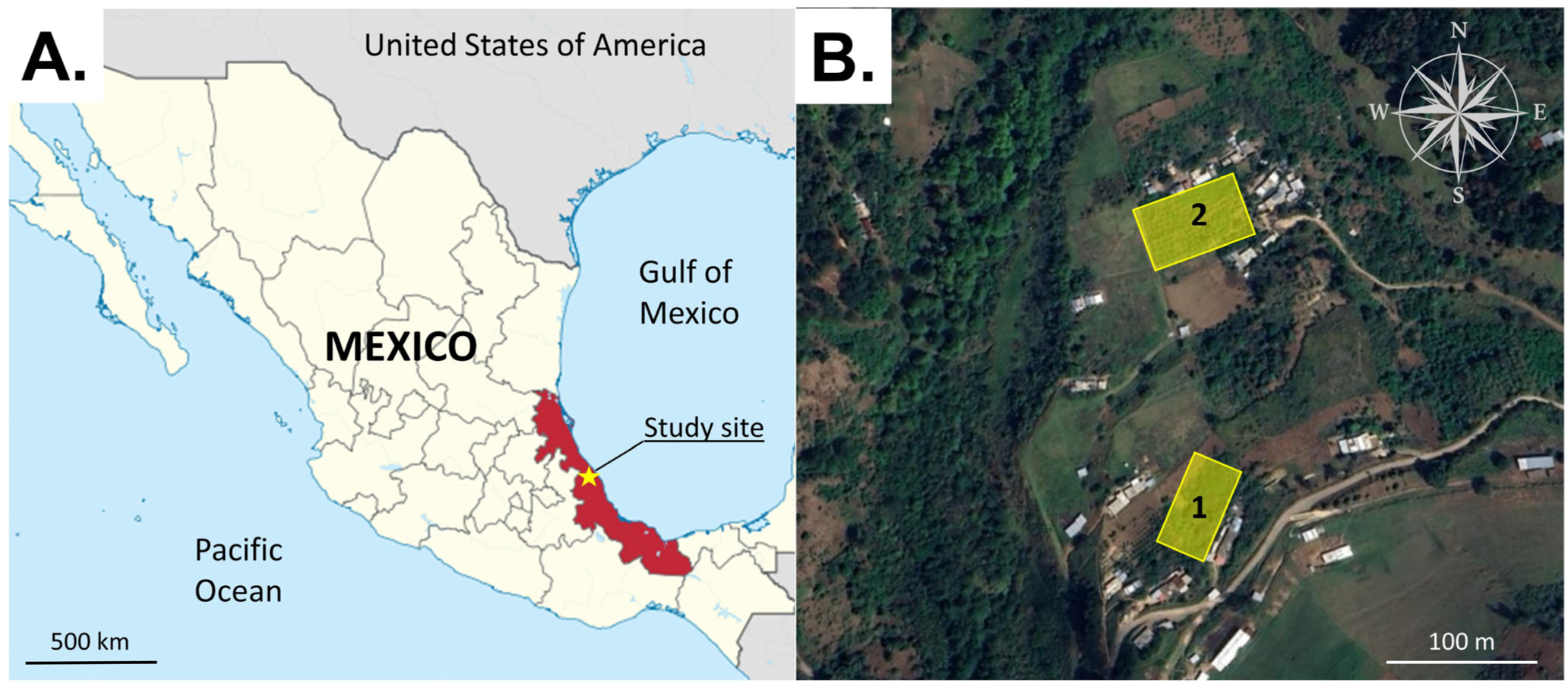
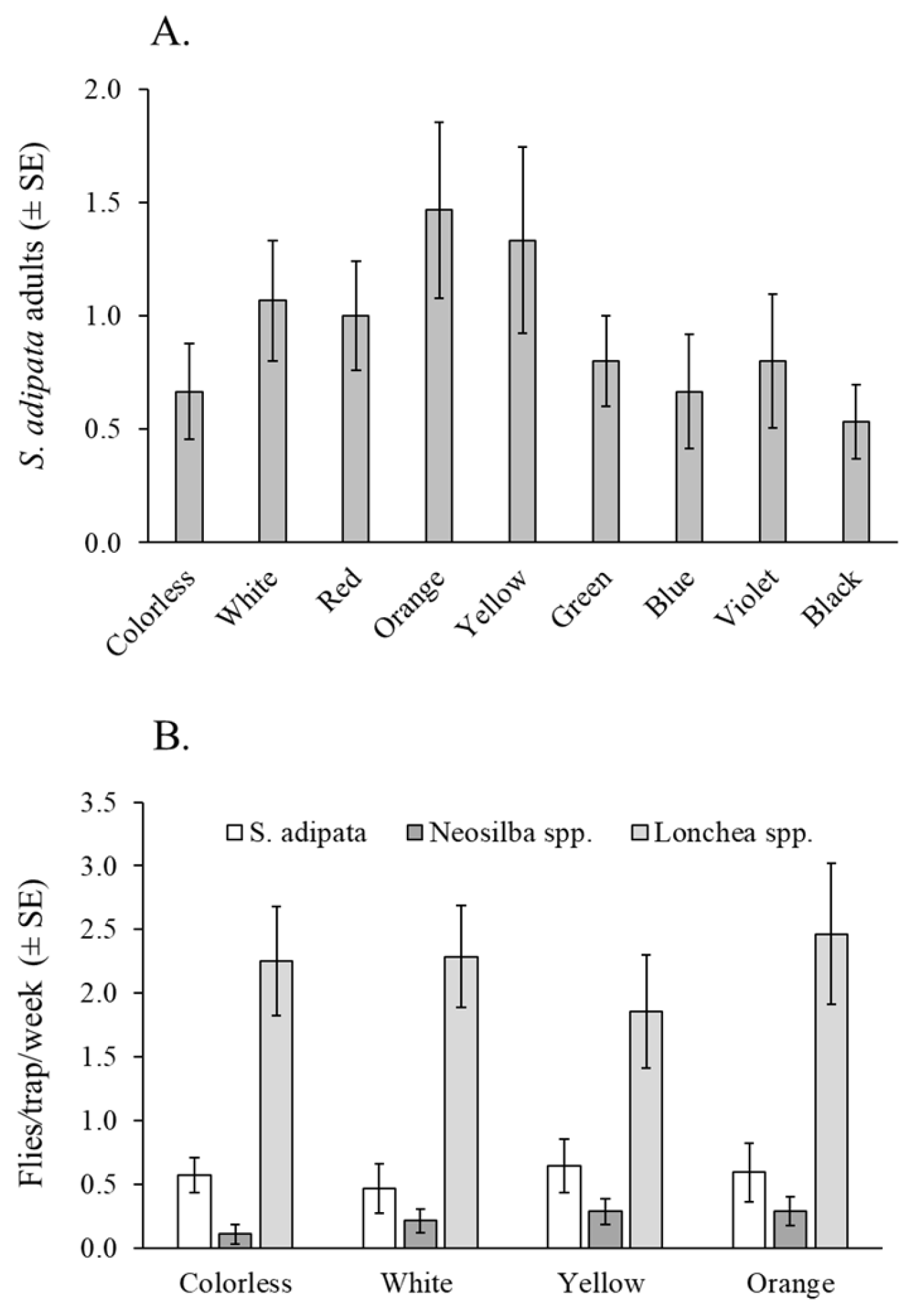
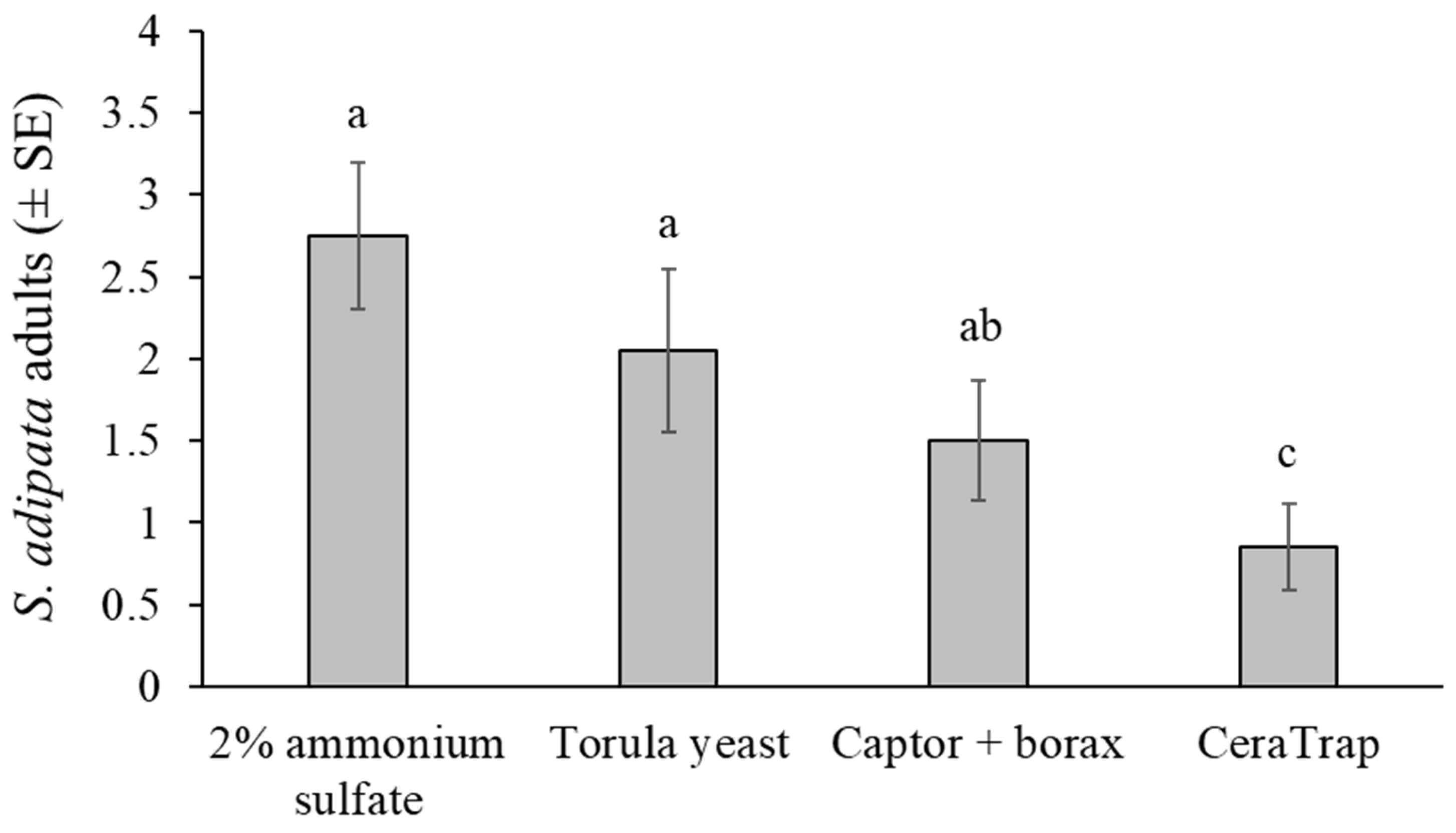
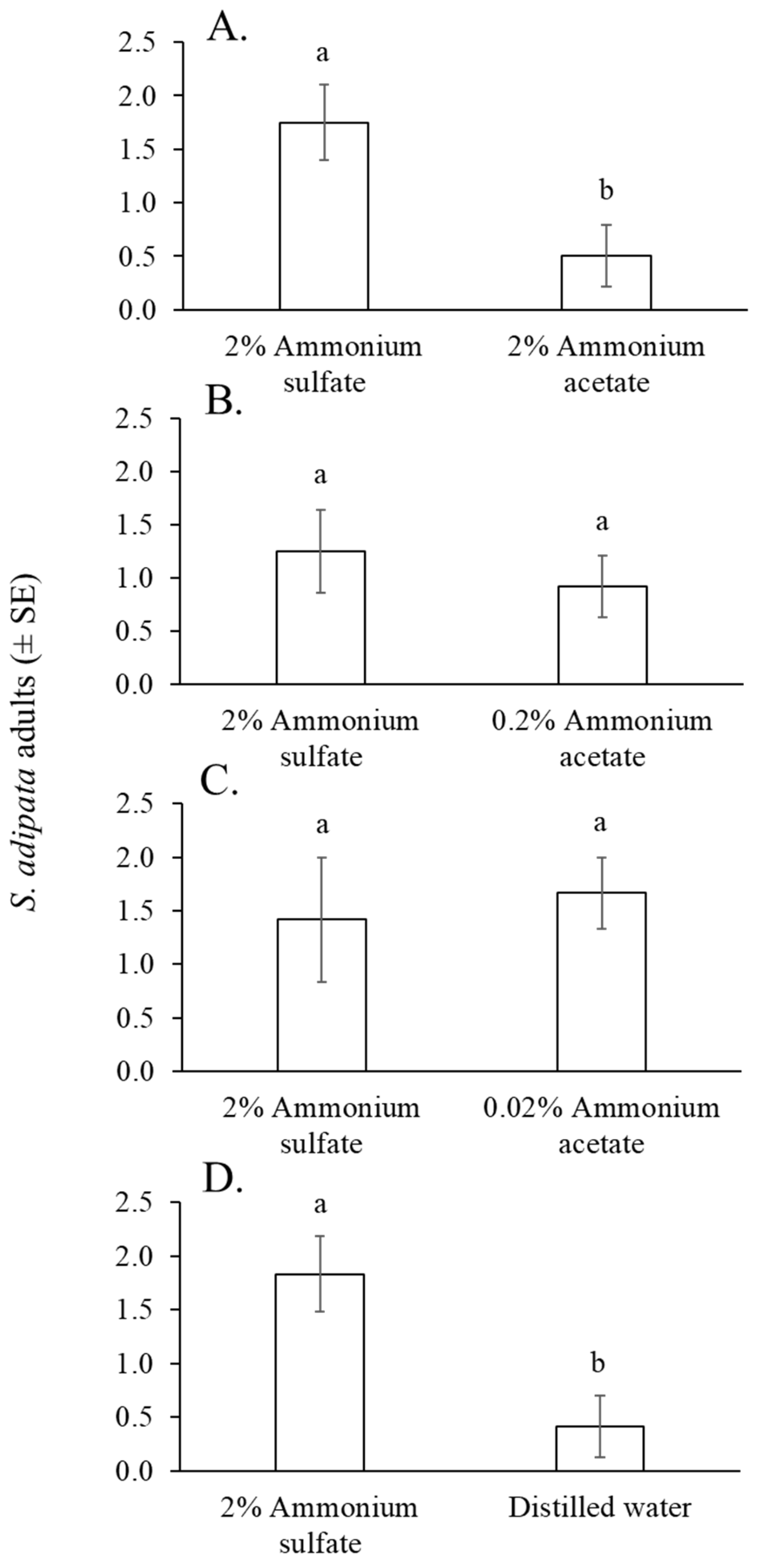

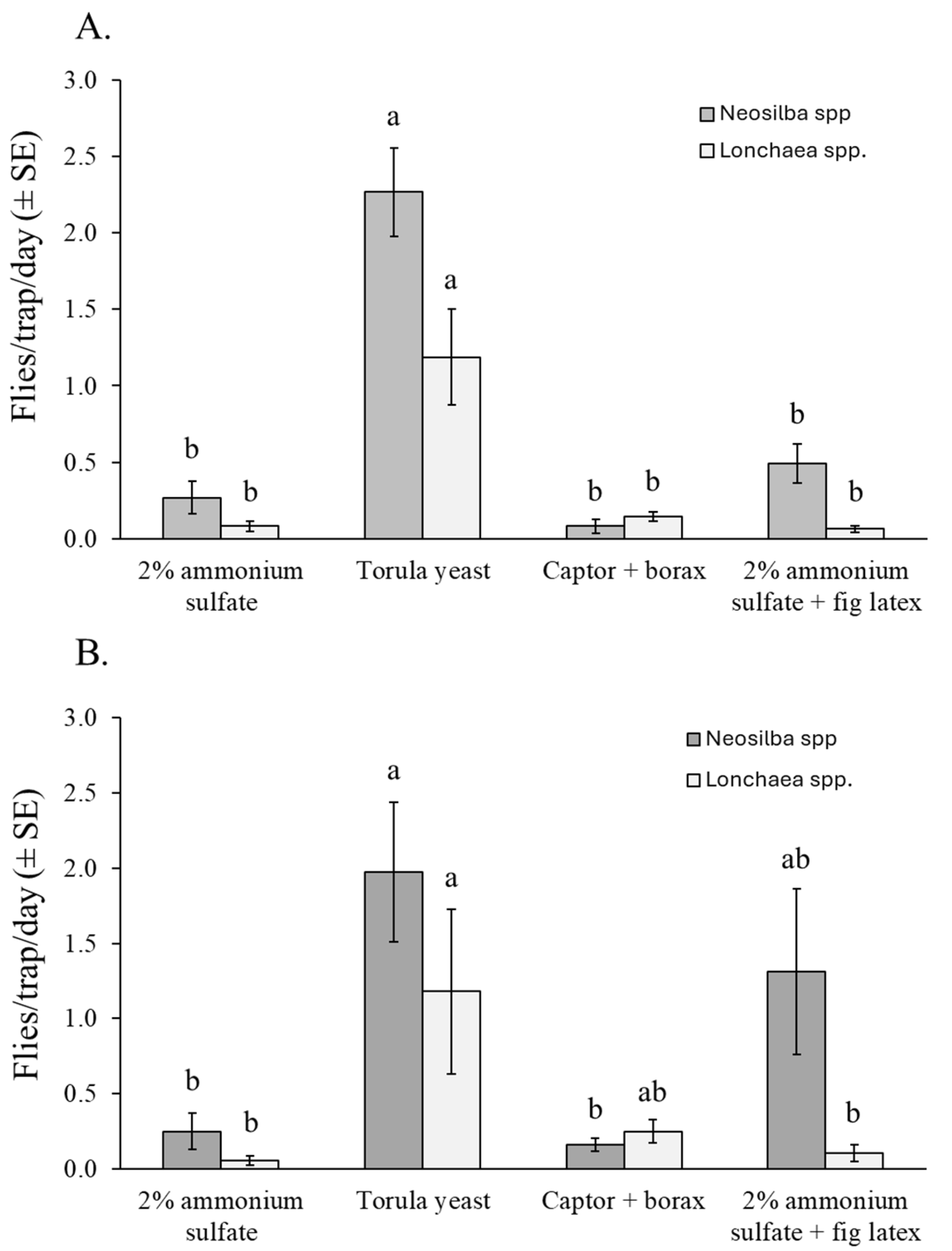
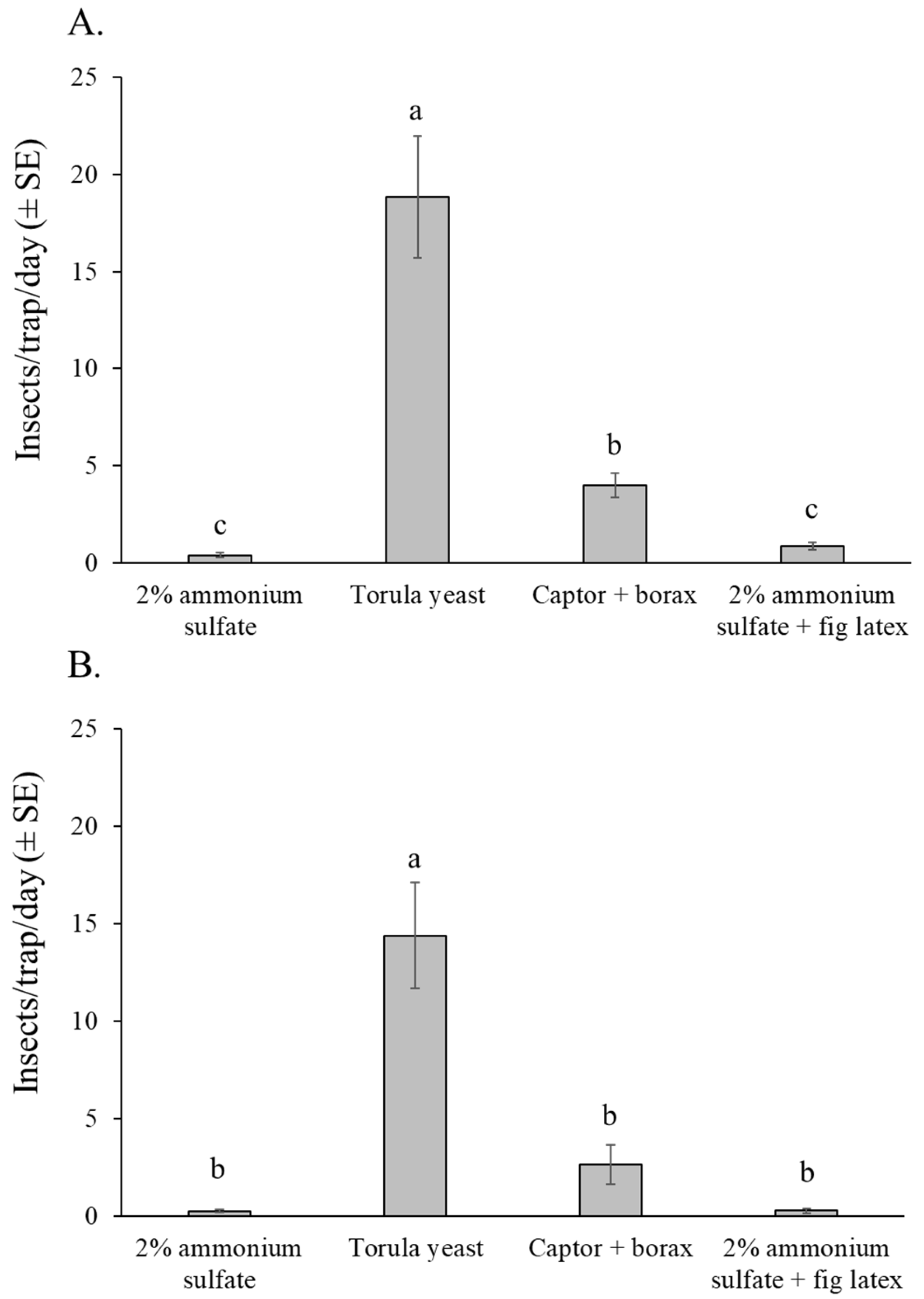
| Attractants | µg/trap/h |
|---|---|
| 2% ammonium sulfate | 3.1 ± 0.4 a |
| 2% ammonium acetate | 3.1 ± 0.3 a |
| 0.2% ammonium acetate | 0.9 ± 0.2 b |
| 0.02% ammonium acetate | 0.3 ± 0.1 b |
Disclaimer/Publisher’s Note: The statements, opinions and data contained in all publications are solely those of the individual author(s) and contributor(s) and not of MDPI and/or the editor(s). MDPI and/or the editor(s) disclaim responsibility for any injury to people or property resulting from any ideas, methods, instructions or products referred to in the content. |
© 2025 by the authors. Licensee MDPI, Basel, Switzerland. This article is an open access article distributed under the terms and conditions of the Creative Commons Attribution (CC BY) license (https://creativecommons.org/licenses/by/4.0/).
Share and Cite
Díaz-del-Castillo, R.; Córdova-García, G.; Pérez-Staples, D.; Birke, A.; Williams, T.; Lasa, R. Color and Attractant Preferences of the Black Fig Fly, Silba adipata: Implications for Monitoring and Mass Trapping of This Invasive Pest. Insects 2025, 16, 732. https://doi.org/10.3390/insects16070732
Díaz-del-Castillo R, Córdova-García G, Pérez-Staples D, Birke A, Williams T, Lasa R. Color and Attractant Preferences of the Black Fig Fly, Silba adipata: Implications for Monitoring and Mass Trapping of This Invasive Pest. Insects. 2025; 16(7):732. https://doi.org/10.3390/insects16070732
Chicago/Turabian StyleDíaz-del-Castillo, Ricardo, Guadalupe Córdova-García, Diana Pérez-Staples, Andrea Birke, Trevor Williams, and Rodrigo Lasa. 2025. "Color and Attractant Preferences of the Black Fig Fly, Silba adipata: Implications for Monitoring and Mass Trapping of This Invasive Pest" Insects 16, no. 7: 732. https://doi.org/10.3390/insects16070732
APA StyleDíaz-del-Castillo, R., Córdova-García, G., Pérez-Staples, D., Birke, A., Williams, T., & Lasa, R. (2025). Color and Attractant Preferences of the Black Fig Fly, Silba adipata: Implications for Monitoring and Mass Trapping of This Invasive Pest. Insects, 16(7), 732. https://doi.org/10.3390/insects16070732







